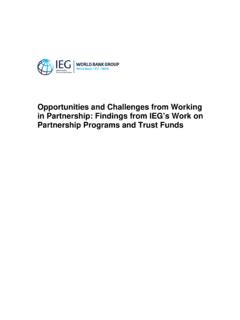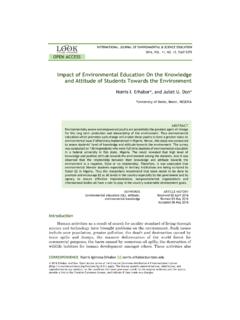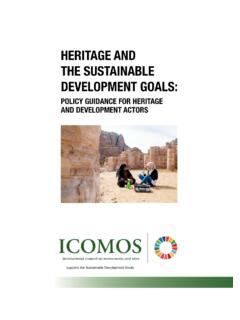Transcription of The role of engineers in the effort to achieve SDG 6 a ...
1 [1] International Association of Hydro-Environment Engineering and Research (IAHR) [2] Swiss Agency for Development and Cooperation (SDC) [3 ] International Migration Organization (IOM) [4] WaterLex [5] UN-Habitat [6] World Council of Civil engineers (WCCE) [7] UNCHR, the UN Refugee Agency [8] UNESCO, International Hydrological Programme (IHP) [9] Office of the High Commissioner for Human Rights (OHCHR) [10] UN Women [11] Women for Water Partnership ( WfWP) [12] International Capacity Development Network for Sustainable Water Management (Cap-Net) [13] International Association of Hydrological Sciences (IAHS) The role of engineers in the effort to achieve SDG 6 a white paper This white paper grew out of the discussion in an open space session proposed by the International Association for Hydro-Environment Engineering and Research (IAHR) during the 32nd UN-Water meeting on 29 January 2020 in Rome with the participation of Angelos Findikakis[1], Pierre Kistler[2], Antonio Torres[3], Geraldine Gene[4], Graham Alabaster[5] and Tomas Sancho[6].
2 Sean Mulligan[1] and Tom Soo[1], who were not present in the UN-Water meeting, also contributed to the development of this paper. The current draft of the paper incorporates comments and additional contributions from Ryan Schweitzer[7], Anil Mishra[8], Abou Amani[8], L o Heller[9], Seemin Qayum[10], Carla Kraft[10], Lesha Witmer[11], Themba Gumbo[12], and Christophe Cudennec[13]. The purpose of this white paper is to provide an overview of the contribution of engineering to the effort to achieve the water-related Sustainable Development Goals (SDGs) of Agenda 2030 and discuss what more they should be doing, including expanding their horizons beyond the confines of their traditional engineering education and the importance of embracing a human rights-based approach. In addition, it explores how the modern paradigm of engineering, which inherently integrates nature-based approaches, contributes and enables national stakeholders to achieve the SDG s through gender-responsive, human rights-based approaches.
3 The Sustainable Development Goals (SDGs) of Agenda 2030 are based on findings from the natural and social sciences and other fields regarding the implementation of necessary changes in order to ensure the survival and prosperity of all people and all forms of life on the planet. The SDGs are underpinned by several human rights principles including the principles of universality and indivisibility, participation and inclusion, equity and non-discrimination, and accountability and rule of law. These principles form the basis of a human rights-based approach. The development of the science of hydrology as a separate field of scientific enquiry in early 20th century provided practical knowledge and information to societal needs in the context of water transport and management, which allowed hydrology and engineering to develop alongside each other. In the first two thirds of the twentieth century, engineering seemed to be the solution to all water problems through the construction of large infrastructure projects to continuously increase the supply of what perceived then as an unlimited resource.
4 In rural areas the emphasis on supply augmentation continued for much of the twentieth century. Despite the positive societal benefits of water infrastructure projects, many had also ecological consequences, such as, for example, large hydroelectric projects(1). 2 Water engineering is multidisciplinary. Historically, civil engineers had a prominent role in water resources development, but other engineering disciplines have progressively contributed more and more to dealing with water issues. This includes, but not limited to, mechanical engineers working on hydraulic machinery and other equipment; chemical engineers supporting different aspects of water and wastewater treatment systems; agricultural engineers improving water use efficiency in irrigation; electrical engineers working on energy production and distribution; electronic and information technology engineers supporting precision agriculture, sensors, metering, and big data processing; and environmental engineers working to assess and minimize the impact of projects on the environment.
5 Even though water resources, engineering and science of hydrology developed essentially in tandem, UNESCO s International Hydrological Decade (IHD; 1965-1974) provided an impetus to begin the global study of water resources available for engineering works. Since the IHD, hydrology has evolved as a transdisciplinary, data-driven science in a remarkably short period of time(13). The intergovernmental International Hydrological Programme (IHP) strengthened hydrology s scientific and technological bases through the development of methods and techniques, guidelines and training, and the human resources capable of ensuring sustainable water management. The reassessment of the impact of large water projects, coupled with increased levels of air and water pollution, led to the environmental movement in the 1970s. Later the United Nations launched the International Drinking Water Supply and Sanitation Decade (1981-1990) in parallel with efforts emphasizing appropriate technologies and focusing on software (non-engineering) problems(11).
6 At about the same time there was a shift from continuing supply augmentation to demand management, often tied to more decentralized and community-based management of water resources, the recognition of the economic value of water, and the realization of the great importance of governance in providing basic water services. These new perspectives effectively combined to reduce the role of heavy infrastructure engineering in the water sector, sometimes overlooking its potentially positive contribution. At the end of the Millennium Development Goals (MDG) period (2000-2015) there was more emphasis on the sustainability of the service and not just the infrastructure, recognizing that non-functionality rates undermined progress towards the MDGs in many areas. Even though UNESCO had an Engineering Initiative (2) addressing engineering education for sustainable development (3), the role of the engineering discipline has not been perceived as pivotal in realizing the SDGs amongst other disciplines in social sciences and humanities.
7 Moving forward, engineering studies must include social analysis of key issues, among them importantly an analysis of the impacts that proposed solutions may have on gender equity, they should incorporate a gender-lens into the social analysis in the discipline of engineering. It is also important to ensure equal access to such education for women. A special challenge in developing a modern curriculum for individual engineering disciplines is finding the right balance between including the range of subjects relevant to sustainability and human rights and at the same time keeping it relevant and recognizable, providing all the required knowledge for practicing the specific branch of engineering. As new technologies start supporting water development and services and as we expand the understanding of social and human rights issues around water and sanitation, it is clear that education cannot stop at graduation from school.
8 It must be a continuous lifelong learning process for practicing water professionals, decision makers and managers. Some institutions, professional societies and special capacity building organizations offer continuous education opportunities. Today, the option of 3 blended learning (online and offline) makes it possible to lower costs and facilitate access to water knowledge and information. It should be noted that various professional institutions representing engineers , such as the Institution of Civil engineers , the South African Institution of Civil Engineering, the American Water Works Association, the International Association of Hydro-Environment Engineering and Research, the World Council of Civil engineers and the American Society of Civil engineers , have adapted and changed with the times to inject innovation and promote best practices to serve their members and society whilst aligning themselves to global agreements and development goals like the SDG s.
9 Looking beyond the water and sanitation for all SDG 6, several other goals are closely related to water issues including SDG 1 (ending poverty in all its forms), SDG 2 (eliminating hunger and providing food security), SDG 3 (ensuring good health and well-being for all), SDG 4 (Target , ensure equal access for all women and men to affordable and quality technical, vocational and tertiary education , including university), SDG 5 (achieving gender equality and empower all women and girls), SDG 7 (affordable, reliable, sustainable and clean energy), SDG 11 (safe, resilient and sustainable cities), SDG 12 (sustainable consumption and production), SDG 13 (climate change), and SDG 15 (biodiversity, forests, deforestation). The problems that led to setting these goals are multi-dimensional and involve potentially conflicting interests, presenting the challenge of how to find win-win solutions.
10 engineers working on such problems must recognize that to address these issues must expand their thinking beyond strictly technical solutions, factor in more prominently social aspects ( gender-sensitive planning, human-rights based approach, and leaving-no-one-behind thinking) and appreciate the importance of looking beyond traditional grey solutions by adopting nature-based solutions. Nonetheless, there has been a significant change in the education and thinking among upcoming engineers . It is no accident that most Civil Engineering Departments in the United States changed their name to Civil and Environmental Engineering where their curriculum was expanded to cover a broad range of subjects, mostly on wastewater treatment and solid waste management, but also other environmental issues, and later to introduce the concept of sustainable development in teaching engineering design.






